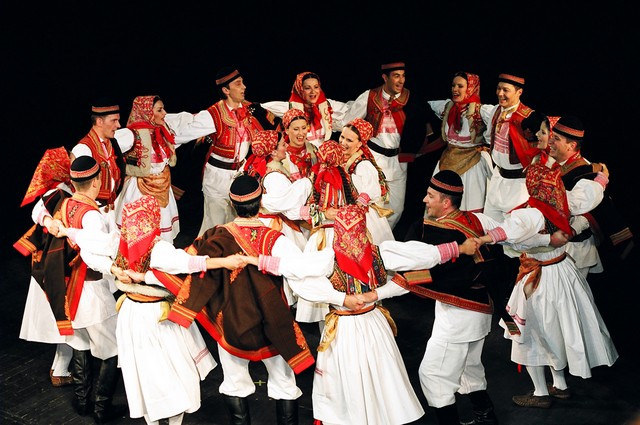Informant FV is my grandfather who was born and raised in Split, Croatia. As a young boy, he grew up in a traditional Croatian family who upheld their culture through dancing Kolo. Kolo is a series of folk dances that vary by region. The word kolo is translated into “circle dance.”
For those you are not familiar with the Croatian culture, explain what kolo is and what it means.
FV: “Kolo means circle dance and it is a series of Croatian folk dances performed across the different regions in Croatia. Kolo is a type of dance performed in a circle formation where the dancers, both male and female, follow specific steps holding hands in one big group circle. There is always music accompanied with this type of dancing.”
What are the different regions within Croatia?
FV: “There are four different regions in Croatia. The first one is called Croatia proper. This region is the central part of the Republic of Croatia and it is where the capital, Zagreb, is located. Zagreb is also the largest city in Croatia. The second region is the region of Slavonia. Slavonia is mostly the eastern inland area of the country. Next is Istria. Istria is a northern peninsula that is the westernmost region of Croatia. It is famous for the city called ‘Pula.’ Lastly is Dalmatia, which is the region I am from. Dalmatia is the majority of the coastline of Croatia and it includes the southern cities of Zadar, Split, and Dubrovnik.”
Which of these regions perform kolo?
FV: “All of these regions have their own form of kolo. For example, for my region of Dalmatia, we perform a type of kolo called Linđo. Linđo represents kolo for the southern parts of Croatia like Zadar, Split, and Dubrovnik. Other regions like Slavonia and Istria, they perform what’s called Šokačko and Balun. Šokačko means ‘the shaker.’ Slavonia has more of a Turkish influence on the dance because it’s inland and because of past history and Istria has more of a Venetian influence because of how close Croatia and Italy are in distance. The city of Split also has been heavily influenced by the Venetian culture because of its location alongside the coast of the Adriatic Sea. Split and the region of Istria sustained the practices and dances from Italy. Turkey never occupied Split or Zadar, so these cities maintained their Italian influenced dances.”
What styles were the kolo costumes influenced by?
FV: “The Croatian national costumes are called ‘Narodna nošnja,’ which means, ‘native or national costume.’ These costumes vary in design, style, material and color based on the location of each region. For example, since Dalmatia and Istria are located on the coast, their costumes consist of Adriatic or Venetian influence. The men’s costumes are usually white or black and have dark trousers that are tighter fitting with a white shirt and a vest. They also wear a red silk belt with a black cap. Women typically wear several layers, which include a white blouse, a skirt with a very colorful apron on top that has red, white and gold stitching and fringe. The women wear colorful scarves with red, white, blue and green, along with beads and coral necklaces, which represents the Adriatic coast.”
In what context would kolo be performed?
FV: “Kolo is danced at every major holiday, festival, party, religious gatherings, weddings, etc.”
When or how did you learn kolo?
FV: “I learned kolo when I was a young boy growing up in my family and by attending special gatherings were it was performed. It is a lot of fun once you learn the steps and the rhythm of the music.”
Does kolo have any significant meaning to you?
FV: “Yes absolutely. Kolo is part of my heritage and culture. It is a large part of our Croatian celebrations and festivities to dance kolo, as it is a form of group dance and performed in a group setting. It is something that we use to express ourselves and the music that goes along with it is very upbeat and fun. Every Croatian knows how to dance kolo. It is something that you learn at a very young age.”
Analysis:
No Croatian festivity or celebration would be complete without kolo. Kolo, or circle dance, is the general term for Croatian folk dance that is performed in the four different regions of Croatia. Each region has their own version of kolo with their own styles of costumes or “nošnja.” Kolo is part of every Croatian social gathering like weddings, parties, and festivals. I personally have a special connection to kolo, as I grew up dancing since I was little with my sister and my friends. I have taught my non-Croatian friends the steps and they find it to be a lot of fun. Our parents and grandparents taught us all at a very young age the steps and songs that corresponded to each dance. Now that I am an adult, I have a greater appreciation that I can carry on my Croatian traditions and rituals to my children. Kolo was an activity that allowed my friends and I to grow closer as it united us together through our cultural ties.
For another version and further information regarding Croatian kolo dance, check out BBC’s article written by Rudolf Abraham:
http://www.bbc.com/travel/story/20140614-fifty-years-of-folk-dancing
Citation:
Abraham, Rudolf. “Fifty Years of Folk Dancing.” BBC. N.p., 14 June 2014. Web. Apr. 2016.

